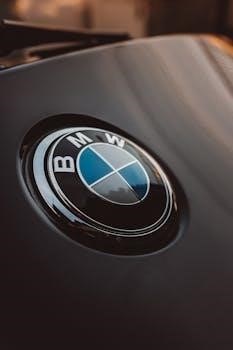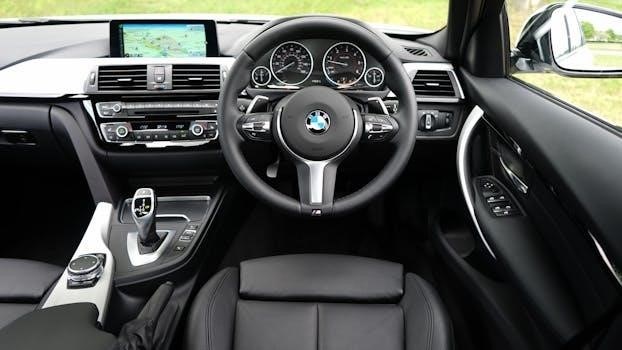
zf 6 speed manual transmission bmw
Overview of ZF 6-Speed Manual Transmission in BMWs
The ZF 6-speed manual transmission, introduced in 1998, quickly gained popularity over its 5-speed predecessor. Its lightweight aluminum design was initially designed for powerful engines but found its way into BMWs. Various models exist, including the S6-650 and S6-750.
ZF 6-Speed Transmission Models (S6-650, S6-750, S6-37)
The ZF 6-speed manual transmission family includes several notable models, each designed for specific applications and torque capacities. The S6-650 and S6-750 are primarily recognized for their use in heavier-duty vehicles. The S6-37 is another significant variant, found in many BMW applications, like the E46. The S6-37 is designed for longitudinal engine configurations and is rated for up to 370 newton-meters of torque. These transmissions represent ZF’s commitment to providing durable and high-performing manual gearboxes, catering to different power and vehicle requirements. The S6-37 model, specifically, is known for its smooth shifting and overall reliability in BMW models.

BMW Models Using the ZF 6-Speed Manual
Several BMW models have utilized the ZF 6-speed manual transmission, including the E46 ZHP, the E89 Z4, and specific E90 models. These transmissions are known for their performance and reliability within the BMW lineup.
BMW E46 (ZHP Model)
The BMW E46, specifically the ZHP performance package model, is well-known for its use of the ZF 6-speed manual transmission, designated as the GS6-37BZ. This transmission is highly sought after by enthusiasts. The E46 330i with the ZHP package is a popular choice for those looking to swap this transmission into other BMW models, such as the E36. This transmission is valued for its robust design and performance-oriented gear ratios, making it a desirable option for both daily driving and track use. The ZHP-specific transmission contributes to the car’s enhanced driving experience, known for quick shifts.
BMW E89 Z4
The BMW E89 Z4 is another model that features the ZF 6-speed manual transmission, particularly in the sDrive30i variant. This transmission is notable for providing a sporty and engaging driving experience. However, some reports indicate that the E89 Z4’s ZF 6-speed may sometimes have difficulty shifting into 5th gear, suggesting the possibility of wear or necessary maintenance, even though other gears might function properly. It’s recommended to inspect these transmissions carefully before installation, potentially opting for a rebuild to ensure optimal performance. Despite potential issues, the transmission is physically robust, with no reports of housing damage.
BMW E90 (Specific Models)
Specific models within the BMW E90 series, particularly the all-wheel-drive variants like the 325xi and 328xi, also utilize the ZF 6-speed manual transmission, specifically the S6-37 model. This transmission is designed for longitudinal engine applications and can handle up to 370 newton-meters of torque. Various engine options within these E90 models, including the N51, N52, N52N, and N53, were paired with the ZF 6-speed. These models offer a blend of performance and practicality, with the manual transmission providing a more engaging driving experience. Owners should note that while generally reliable, regular maintenance is key to its longevity.

ZF 6-Speed Manual vs. 5-Speed Comparison
The ZF 6-speed manual transmission primarily differs from the 5-speed by including an overdrive gear, offering potentially better fuel economy at highway speeds. The 5-speed is known for its durability except in some gears.
Gear Ratios and Overdrive
The ZF 6-speed manual transmission typically features similar gear ratios to the preceding 5-speed in the lower gears. The most significant difference lies in the addition of a sixth gear, which acts as an overdrive. This overdrive gear is primarily designed to improve fuel efficiency during steady-state highway driving by allowing the engine to operate at lower RPMs for a given speed; This results in reduced engine wear, noise, and fuel consumption. The presence of an additional gear allows for a smaller drop in engine speed during upshifts, keeping the engine within its optimal powerband and contributing to a smoother driving experience. The 5-speed version, lacking this overdrive, often leads to higher engine speeds and fuel consumption.
Durability and Common Issues
The ZF 6-speed manual transmissions are generally considered robust and durable gearboxes. However, like any mechanical component, they are prone to specific issues. Some owners have reported difficulties in shifting into fifth gear, which can sometimes indicate internal wear. The 5th and reverse gear gates are sometimes known to stick. While the transmission is designed for high performance, some owners have also experienced issues with the 1st to 2nd gear shifts when pushed hard. These issues, however, may also stem from other parts like linkages or worn clutch components. Regular maintenance and fluid changes are essential to ensure the longevity of the transmission.

Maintenance and Reliability of ZF Transmissions
ZF transmissions are generally reliable, but proper maintenance is key. Regular fluid changes based on ZF recommendations are important for longevity. Some issues can arise with age and mileage, so inspection is advised.
Fluid Changes and Recommendations
Maintaining the proper fluid level and condition is crucial for the longevity of ZF transmissions. Regular fluid changes, adhering to ZF’s specific recommendations, are essential. It’s important to use the correct type of oil, as specified by the manufacturer; some ZF transmissions are designed to use engine oil as lubricant. Monitoring the fluid for any metal shavings or abnormalities during changes can help identify potential issues. Failing to perform fluid changes can lead to shifting problems and premature wear. Consulting a qualified mechanic for proper fluid replacement is highly advised to ensure the correct procedure is followed and the correct fluid is used.
Common Issues
While generally reliable, ZF 6-speed manual transmissions can experience some common issues. These include difficulties shifting into certain gears, particularly 5th, which sometimes require inspection or rebuilding. Some owners have reported glitches in shifting at light throttle and sticking issues with the 5th gear/reverse gates. Mechatronic sleeve leaks, leading to oil loss, can also occur. Furthermore, some transmissions may exhibit an uptick in revs during upshifts. Identifying and addressing these issues promptly through proper maintenance and repair is important to ensure the transmission’s continued performance and longevity, potentially avoiding more significant problems.

Installation and Adaptations
The ZF 6-speed manual transmission can be adapted for various applications. This includes swaps between BMW models, like the E46 to E36, and adapting it to non-BMW engines, such as Ford EcoBoost engines.
E46 to E36 Swap
Swapping a ZF 6-speed manual transmission from an E46 into an E36 is a popular modification among BMW enthusiasts. This conversion requires the transmission itself, along with a matching clutch and flywheel. The shifter linkage needs shortening to fit correctly in the E36 chassis. Additionally, the front half of the driveshaft requires modification, being longer than an automatic but shorter than an E36 manual shaft. While the swap is relatively straightforward, it’s important to consider these modifications for a successful installation. Many find the improved gear ratios and the additional gear enhance the driving experience of the E36.
EcoBoost Engine Adaptations
Adapting a Ford EcoBoost 2.0L or 2.3L engine to a BMW ZF manual transmission is achievable with specialized kits. These kits include a bell housing adapter, a billet ZF6 flywheel, pilot bearing, alignment dowels, and all necessary hardware for connecting the engine to the transmission. Such setups have been tested in performance applications, demonstrating their reliability. By using this adapter kit and pairing it with an E36 or E46 engine mount kit, the original BMW transmission, mounts, and driveshaft can often be retained, simplifying the process. This allows for a robust and unique powertrain combination.
Lubrication and Oil Types
ZF transmissions, including some 6-speeds, use specific oils for lubrication. Some models even use engine oil, like 10W-60, as a recommended alternative. Following manufacturer recommendations for oil is crucial.
Recommended Oils
For ZF 6-speed manual transmissions in BMWs, selecting the correct lubricant is crucial for optimal performance and longevity. Some ZF units use specific transmission fluids, while others, notably the S6-40, may utilize engine oil. The recommended oil for some applications is a BMW-imported Castrol 10W-60, now superseded by TWS, or a GM 5W-30 oil. Always refer to the specific manufacturer’s recommendations for your particular transmission model. Using the wrong fluid can lead to shifting issues and potential damage. Regular fluid changes with the appropriate oil are key to maintaining the transmission’s health. It is also important to ensure that the oil meets the required specifications for the specific transmission model.
Engine Oil as Lubricant
Interestingly, some ZF 6-speed manual transmissions, particularly the S6-40 found in certain applications, use engine oil for lubrication instead of traditional transmission fluid. This is a unique design aspect that requires specific attention when performing maintenance. The use of engine oil, such as a high-quality 10W-60, as recommended by ZF and BMW for these transmissions, is critical. Using the wrong type of oil in these units can cause serious issues. It’s crucial to verify the exact specifications for your transmission before adding or changing any fluids. The specific reason for this design decision by ZF is not clear, but it’s part of their engineering. Always consult manufacturer guidelines and qualified mechanics when dealing with this type of lubrication.